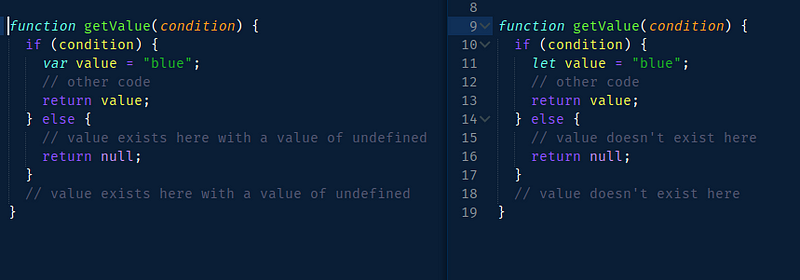Modern ES6+ JavaScript Pt. 2
Open Source Your Knowledge, Become a Contributor
Technology knowledge has to be shared and made accessible for free. Join the movement.

Part 2: Var vs Const vs Let
This article is Part 2 for the Series “Modern ES6+ Javascript for those who know only a little about that old Javascript.”
Welcome back, In the previous article we covered an Introduction to this weird Language called JavaScript. Today we will learn about var, const and let.
Credits: This Part of the Article series has been referred from the book “Understanding ECMAScript 6 by Nicholas C. Zakas”.
Traditionally, the way variable declarations work has been that weird part of programming in JavaScript. Variables creation depend on how you declare them, and ES6 offers options to make controlling scope easier. This article will look to clear on why those classic var declarations can be confusing and will also introduce block-level bindings aka const and let.
Variable declarations using var get treated as if they are at the top of the function (or global scope, if declared outside of a function) regardless of where the actual declaration occurs; this is called hoisting. See the example below to see what hoisting does:
If you are new to JavaScript, you might think that the variable value only to be created if the condition evaluates to true. In fact, this is not how JavaScript engines work behind the scenes; the variable value gets created regardless as the engine changes the getValue function to look something like this:
The declaration of value is hoisted to the top, while the initialization remains in the same spot. That means the variable value is still accessible from within the else clause. It happens to be like this as the variable would just have a value of undefined the other way around as it hasn’t been initialized.
It is obvious and understandable that will not be easy for new JavaScript developers to learn declaration hoisting, but please note that misunderstanding this unique behavior can end up causing bugs. To resolve this ES6 introduced block level scoping options to make the controlling a variable’s lifecycle a little more powerful.
Block-Level Declarations
Block-level declarations are the ones that declare variables that are far outside of a given block scope. Block scopes, also known as lexical scopes, are created either inside of a function or inside of a block (indicated by the { and } characters). Block scoping is how many C-based languages work, and the introduction of block-level declarations in ECMAScript 6 is intended to bring that same flexibility (and uniformity) to JavaScript.
Let Declaration
The let declaration syntax is the same as var. You can replace var with let to declare a variable, this will limit the variable’s scope to only that current code block. Since let declarations are not hoisted to the top of the enclosing block, you may want always to place let declarations first in the block, so that they are available to the entire block. Here’s a quick example:
Here below is the screenshot that shows the difference between var and let (Check the comments within the code block).

As you can see, the getValue function with let behaves similar to other programming languages. As, variable value is declared using let instead of var , the declaration isn’t hoisted to the top of the function definition, and the variable value is no longer accessible once execution flows out of the if block. If condition evaluates to false, then value is never declared or initialized.
No Redeclaration
If a identifier has already been defined within the scope, then using identifier in a let declaration inside that scope throws an error. Check below:
In this example, the count is declared twice: once with var and once with let. As let will not redefine an identifier that already exists in the same scope, the let declaration will throw an error.
On the other hand, no error shows up if the let declaration creates a new variable with the same name as a variable in its containing scope, check the code below:
This let declaration does not throw any error as it creates a new variable called count within the if statement, instead of creating the count in the surrounding block. Inside the if block, this new variable shadows the global count, which prevents access to it until execution leaves the block.
Constant Declarations
Also, you can define variables in ES6 with the const declaration syntax. Variables that are declared using the const keyword are considered constants, which means that their values can’t be changed once set. Thus, each const variable must be initialized on the declaration, as shown below:
The maxItems variable is initialized, so its const declaration should work without any problems. The name variable, however, would cause a syntax error if you tried to run the program containing this code, because name is not initialized.
To be continued… Thanks for reading this through, Part 3 is here.
Thanks a lot…
If you would like to hire me for your next cool project, or just want to say hello… my twitter handle is @harmanmanchanda for getting in touch with me! My DM’s are open to the public so just hit me up.